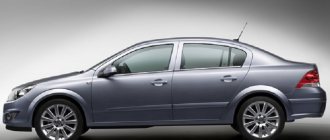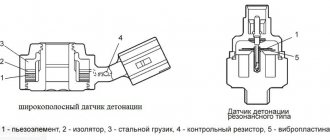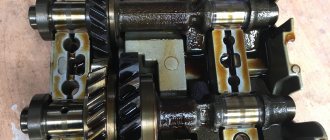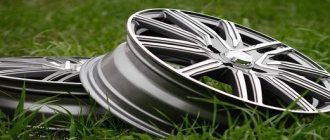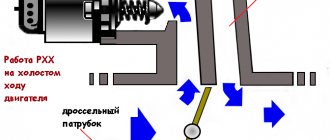Until the mid-90s of the last century, there were no such concepts as “crossover” or “SUV”; for passenger cars there was only the class of SUVs - cars had all-wheel drive, a frame structure and a high body.
The first crossovers in the world were the Toyota Rav4 and Honda CRV car brands - Toyota appeared in 1994, and a year later Honda debuted. The CR-V model is still in production today; during its existence there have been four generations.
Honda CRV RD1
Although the SRV is not an SUV as such, it has very good cross-country ability, especially in the all-wheel drive version. The first Honda CRV cars began to be produced in Japan, in the city of Sayama, as well as in England (the city of Swindon); this model was created on the basis of the Honda Civic passenger car. Right-hand drive crossovers were produced for the Japanese market, and for the North American market, the first car was presented in 1996 at the Chicago Auto Show; crossovers went on sale in February 1997.
At first, the Honda was produced in only one configuration (LX), the car was equipped with a two-liter gasoline engine with a capacity of 126 hp. With. (model B20B), which outwardly was almost no different from the Honda Integra 1.8 liter internal combustion engine, but had an increased cylinder diameter (84 mm). Honda SRV of the first generation were produced in three bodies:
- RD1 – all-wheel drive;
- RD2 – cars with front wheel drive;
- RD3 – restyled version.
In 1999, the Honda CR-V underwent a slight restyling, and although it did not change at all in appearance, it began to be equipped with a more powerful B20Z engine (147 hp). The new power unit had modified internal combustion engine manifolds and increased the compression ratio in the cylinders.
Later, the EX package appeared, which included alloy wheels with a radius of 15, and an ABS system was installed. Any Honda CRV-1 was equipped with a picnic table, and the rear seats folded into the “floor,” which was a rarity at that time. For many countries, the car was supplied with a chrome radiator grille, but in the American version this part was made of black plastic, and the bumpers were the same color.
Honda CRV RD1 is a car with good handling, with front and rear multi-link suspension. Basically, all first-generation cars were equipped with a 4-speed automatic transmission (there are not many cars with a 5-speed manual transmission), and even with a weak 126-horsepower engine they had good dynamics. The first generation CRV was produced until 2001, then it was replaced by the Honda SRV-2 model.
Cars with SUV qualities had automatic rear-wheel drive (AWD), which was later used on many modern crossovers.
Brake system
The brakes of the third generation Honda CR-V crossover are highly efficient and reliable, and the factory parts last a long time.
Brake pads (front and rear) usually last for 40-50 thousand kilometers, although even here a lot depends on careful operation.
Brake system discs, both front and rear, can easily last up to 90,000 km; for spare parts, many car owners advise buying parts from Brembo, TWR or Bosch brands.
Honda SRV 2nd generation
The CRV-2 crossover was produced by the Honda automobile company from 2002 to 2006, the car was presented in bodies starting with RD-4 and ending with RD-8:
- RD4 – pre-styling, with a 4x2 wheel arrangement;
- RD5 – pre-styling, with 4x4 wheel drive;
- RD6 – restyling, front-wheel drive version;
- RD7 – restyling, with all-wheel drive;
- RD8 is a car for the European market, with a 2.0 liter engine.
In the second generation, the vehicle's landing position became lower and the body height increased. Due to this, the interior became more spacious, although outwardly the car did not look larger in size. On the Honda CR-V 2, the line of power units expanded - a K24A1 power unit with a volume of 2.4 liters and a power of 160 hp appeared. With. The transmission was also changed, and on cars of this generation it is already presented in four versions:
- 5 and 6 speed manual transmission;
- 4- and 5-speed automatic transmissions (“five-speed” was mainly installed on cars for the American market).
The Honda SRV (2nd generation) is based on the Honda Civic-7 passenger car (2001-2005), and the crossover turned out to be so successful that it was recognized as the best in the world according to the magazine “Car and Driver”. In 2005, the car was restyled, the changes affected:
- front and rear optics;
- radiator grilles;
- rear and front bumpers;
- front fog lights.
The updated model already had 16-radius wheels instead of R15 in the pre-restyling version, and the radio control buttons were now located on the steering wheel.
The front seats in the SRV-2 cabin are wide and comfortable, with many adjustments, the instruments on the panel are easy to read and have good information content. The quality of the interior trim is not bad, but the plastic is a bit harsh. It should be noted that the CVR instrument panel of the first release is trimmed with leatherette, and therefore looks more noble. The CRV-2 is equipped with two airbags; the basic equipment includes air conditioning and heated front seats and mirrors.
Crossovers after 2005 supplied to the USA began to be equipped as standard with:
- ABS and ESP systems;
- stabilization system;
- side airbags.
Also in 2005, a 2.2 liter turbodiesel with a capacity of 140 hp appeared in the Honda CR-V engine line. pp., the power unit was intended for cars on the European market. It should be noted that the SRV-2 version was available for Russia only with a two-liter gasoline engine.
III generation (2007-2011)
The third generation consolidated the tradition in which potential owners chose between two gasoline engines. The older version with a volume of 2.4 liters continued the development of a series of engines with the K24 index. A more modest 2.0-liter version was a representative of the new R series for the CR-V model.
- 2.0 l. (150 hp) R20A;
- 2.4 l. (166 hp) K24Z1.
The R series engine is a modification of the 1.8 liter R18 engine. It first appeared on the 8th generation Civic model. The increase in volume was achieved by installing a long-stroke crankshaft. The modified intake manifold has 3 operating modes. The motor also acquired balancer shafts. The cylinder head has a SOHC design, that is, with one camshaft, but it has 16 valves. There is an i-VTEC phase change system. The mechanism drive itself is chain driven.
It is noted that, compared to its predecessor the K20 series, the engines of this series have a more “urban” character. The emphasis is on low and medium speeds. We can say that the bright sporting character has disappeared. At the same time, efficiency has increased, and the relative simplicity of the design has increased the reliability of the unit.
Article on the topic: Choosing a rolling jack
The K24Z1 engine received certain modifications, which improved its performance. The intake manifold received changes, and a different connecting rod and piston group began to be installed. This allowed the power to be increased to 166 hp.
Both engines do not have hydraulic lifters, so owners need to remember to periodically adjust the valve clearances. The manufacturer specifies an interval of 40 thousand km.
Typical faults
The R20 series engine can sometimes be annoying with its knocking. There are two fairly common reasons. The first is the valves. This can happen either due to incorrect adjustment or because this procedure has not been performed for a long time. The second common reason is the characteristic sound of the adsorber valve. This is considered a normal design feature.
Sometimes the drive belt tensioner can add unnecessary sounds. As practice shows, its service life is on average 100 thousand km, after which it may require replacement.
A feature of the engine is vibration when cold. If it continues after warming up, then first of all you should check the supports. Most often the reason is on the left.
When using low-quality fuel, the service life of the catalyst and lambda probe can be significantly reduced. It is also worth paying attention to the quality of the oil. The i-VTEC system is very sensitive in this matter.
K24 series motors can cause more problems. This mainly concerns malfunctions associated with exhaust camshafts, or rather with their regular wear. There are many theories about why this malfunction occurs time after time after repair, but there is still no exact answer. The owners can only change the wearing part, or repair the cylinder head.
The remaining problems were also inherited from the predecessor K24A1, but they are not so critical and can be easily solved thanks to the operating experience of the previous modification.
Engine life
Motors of the R20 series are quite reliable and can easily last up to 200 thousand km. Many copies reach up to 300 thousand. The key to such mileage is timely maintenance and the use of high-quality oil.
The K24Z1 engine is of course more troublesome due to its problem with the camshafts. It is worth noting that if we ignore this problem, the unit is quite reliable. Its resource potential makes it possible to increase mileage of 300+ thousand km before major repairs. But this is also possible subject to high-quality and timely service.
Third generation "C-R-V"
The debut of the third generation of the Honda crossover took place in September 2006, and it went into production in 2007. This car was somewhat shorter in length and lower in height, the body of the CRV-3 became more streamlined, and the spare wheel was moved from the “outside” of the rear door to the trunk. The line of power units remained almost the same, but the engines were somewhat modernized. The engines installed on the Honda SRV-3 are the following models:
- R20A – 1997 cm³ (gasoline);
- K24Z – 2354 cm³ (gasoline);
- N22A – 2204 cm³ (turbodiesel).
In 2007, the Honda CR-V became so popular in America that it entered the top ten best-selling cars, and in 2008 it became the leader in sales and popularity. In 2010, the car was restyled, and in 2011, production of the model was discontinued; the fourth generation crossover took over the baton.
The most common defects in the body and interior
The paintwork on the Honda CR-V 3 is relatively thin and scratches easily, but the body metal resists corrosion well and practically does not rust.
Chrome also does not peel off, only occasionally yellowness may appear, but in order to avoid problems, it is advisable to treat the bottom with an anti-corrosive agent.
The main “sores” on the body of the Honda CR-V 3 crossover:
- weak door seals;
- not very reliable fastenings of the front bumper under the headlights;
- failure of door stops;
- The sound insulation is not the best; car owners often modify it on their own.
Another sore point for owners of SRV 3 is the trunk door, water flows from it when opened, literally down the collar.
Honda CRV 2008
The 2008 Honda CR-V is a compact SUV (crossover) of the third generation in the pre-restyling version. The main competitors of the SRV-3 are the Toyota Rav4 and Subaru Forester, and the Honda, although slightly inferior to the Subaru in terms of comfort, looks more solid, and most importantly, you can buy the car at a very attractive price.
The design of the Honda CR-V 3 can hardly be called “feminine” - the car looks quite aggressive, with some pretension to “sportiness”. The interior of the car is quite spacious - it comfortably accommodates both the driver and passengers in the front and rear seats. The backrests of the rear seats are adjustable and also move back and forth, so passengers can find a comfortable position during a long trip. There is also an armrest in the rear of the cabin, and it has two cup holders.
The trunk lid opens entirely from the bottom up, rather than sideways, as was the case on previous CR-V models. The luggage compartment has a shelf that folds easily, and there is also a curtain. On the left side of the luggage compartment there is a socket for connecting various consumers, under the floor there is a small stowage compartment (a half-size spare wheel).
The 2008 Honda CR-V is equipped with two types of gasoline engines - 2.0 and 2.4 liters; for European countries, the car is also available with a 2.2 liter diesel engine. Turbodiesel compares favorably with gasoline internal combustion engines in its low fuel consumption and high-torque power, but in Russia it “takes root” with difficulty - diesel does not “tolerate” low-quality domestic diesel fuel well. For Russian conditions, it is preferable to buy a Honda SRV car with a 2.4 liter power unit - the internal combustion engine and gasoline consume moderately, and has excellent dynamics.
Engine K24Z - 4-cylinder, in-line, 166 hp. pp., has a timing chain drive. The motor is very reliable and practically does not break down, but this does not mean that it can not be maintained. In the pre-restyling version of 2008, two types of transmission are provided - a 6-speed manual transmission and a 5-speed manual transmission. Automatic transmission and gearboxes also cause no complaints. Rear-wheel drive on all-wheel drive vehicles is connected automatically when off-road, without any jerks or delays.
All owner reviews about Honda CR-V III
Well, the time has come to part with the car... The speedometer has 80,000 km, 3 years of operation behind it, thank God, not a single accident or any serious breakdowns. I’ll say right away that after 80 thousand km of operation I replaced: brake pads, windshield (a stone flew in) and the air conditioner clutch bearing. The latter, IMHO, and familiar auto specialists also think it’s a Honda jamb, well, it shouldn’t have started humming after 3 years of operation, dirt shouldn’t have gotten into it. In the salon they immediately asked me: “Did you cross the river ford?” No, dear Honda people, no, I didn’t, but the bearing suddenly began to hum. They gave me a price tag of 17 thousand rubles only for the spare part (bearing assembly with clutch), but because... The warranty ended, so I removed the coupling, bought a new (Japanese) bearing, they pressed it in for me instead of the old one - a total of 2,750 rubles. In the salon, IMHO, there would be no less than 25 thousand with work. Well, and one more thing - in three years, only once did I have to run after a tractor, well, here, without undue modesty, to the good cross-country ability of the Honda, you can add, to put it mildly, the common sense of the gasket between the steering wheel and the seat... Although not a single person pulled out people, or rather their cars times, especially in the last snowy winter. Well, I also changed the battery, the original one was only 45 Ah, and took it to 75. In our Ural winters, this is relevant. I also made the running lights (fog lights) turn on automatically when the key is inserted into the ignition.
Well, about the sad stuff, that’s probably all; otherwise, the car only made me happy. Even now, having put it up for sale, I’m even sad to part with it, and, to be honest, I can’t really explain to myself the reason for replacing the car - well, it didn’t give me a reason, it honestly drove for all 3 years, for which I bow to it. The car has been in production for more than 4 years, but the appearance, IMHO, is quite modern, at least “good”. There are no particular complaints about Honda’s paintwork, no matter how much they scold the Japanese for the “weakness” of the paint. And almost nothing has changed inside in 3 years, only there are scratches on the plastic near the gearbox switch (scratched with metal parts of the purse, the plastic there is “soft”) and the fabric upholstery of the driver’s seat has lost its former appearance a little, but if only I had thrown on it in winter something like sheepskin, but why? It’s not leather, the seat would be like new. The car holds the road well, and, to be honest, I’m a big fan of accelerating around corners. I don’t race on straight sections (mostly I cruise at 100-120 km/h), but I take off on turns. Even in the Yokohama winter, everything was within normal limits. By the way, I noticed that in winter a rare car overtook a Honda, especially in sections with turns (I mean the following situations: the road is not cleared and there is snow or ice on it; it is snowing heavily), in a word, it behaves confidently, predictably on the road, even forgiving, thanks to its electronics, some of the driver’s mistakes.
That's all. I would have left the Honda in the family for my wife, but in May I already bought her a Nissan Juke; I had no intention of parting with the Honda then. The only reason that prompted me to sell my Sideboard was the unstable financial situation in our Honduras. After the elections in March, I feel that some kind of kick-ass will come, as the hero of the film “Moscow Doesn’t Believe in Tears” said - “there is no stability in the world.” Car prices are rising, and quite noticeably. So in September I figured out what I wanted next. I settled on Toyota LK Prado, Audi Q5 and Lexus RX270. I’m actually an Audi fan, but after thinking reasonably, reading reviews and talking with Q5 and Q7 owners, I realized that I’m not ready to pay 2-3 million rubles for a car that requires a service visit not only for maintenance, but also when constantly some light bulbs burn out, the electronics malfunction, and the suspension requires a more careful attitude towards it, but in the Urals we have good roads, mainly only those that lead to Yekaterinburg, and in the cities themselves there is not a fountain, but those that in the yards, IMHO, in general, since the times of Nikita Sergeevich and Leonid Ilyich, they have not been repaired... And over time, the products of the German automobile industry lose more in price than the same Lexus. Thus, having put reliability first, I again turned my attention to the products of the Japanese automobile industry, which, pah-pah, has still not given me a reason to be disappointed in myself. In short, I chose Lexus, largely taking into account the experience of operating the CR-V, and it is somewhat similar to the Honda, even its height and ground clearance are the same.
Fourth generation Honda CRV
The debut of the 4th generation SRV took place in 2011 at the AutoShow exhibition in Los Angeles; the car has been in mass production since 2012. A 1.6 liter power unit, developed for Europe, was added to the linear range of SRV-4 engines; the crossover was initially produced with two types of transmission:
- five-speed automatic transmission;
- nine-speed automatic transmission (European version).
In 2014, a restyled version of the CR-V 4 was presented to the world - this car added a six-speed CVT made in Japan, an internal combustion engine with a direct fuel injection system. On the restyled model, the suspension was modernized, and in the American version, electronic equipment was expanded.
Repair and tuning Honda SRV
There are few weak points in the Honda CR-V, but various breakdowns still occur periodically. On first-generation cars, automatic transmissions may fail, rear springs often sag, and the radiator leaks (a crack may form next to the drain plug). On the Honda CR-V 1 there are problems with the heater and air conditioning; these breakdowns are most typical for cars produced in 1997-2001.
The Honda SRV 3 has one characteristic nuisance - when opening the trunk door, the water accumulated on it flows directly onto the person, and it is difficult to do anything about it. Even in cold weather, the door may not open completely - the shock absorbers of the trunk lid freeze. On any SRV, fuses periodically blow, the sound insulation is not very good, and many car owners tune the car - install additional “noise” in the doors and floor in the cabin.
Ball joints can fail, but the culprit here is usually the anthers, which often tear on non-original parts. When replacing a ball joint, motorists advise removing the old boot from the old part (if it is intact) or purchasing original spare parts.
Although the Honda CRV has fairly good cross-country ability, it is not an SUV as such. To improve off-road performance, the car is often tuned and a suspension lift is installed. On a crossover, ground clearance is increased using spacers or special reinforced springs of increased length; there are special lift kits - they are produced by various manufacturers. The installation of reinforced springs on fourth-generation CVR cars is especially relevant - the car’s ground clearance is only 170 mm.
Related articles:
- New SUVs up to 1,000,000 rubles in 2020 In this article, we will try to figure out which new SUVs under 1,000,000 rubles can be bought in Russian car dealerships in 2020, which crossovers are the most popular among Russians [...]
- Fuel consumption of a Chevrolet Niva with different engines The Chevrolet Niva has been produced in Tolyatti since 2002, the model is very popular in Russia. The compact SUV has excellent cross-country ability and is 90% domestic […]
- What are the most reliable engines in the world? This article will consider both the most reliable engines in the world, which do not break down for a long time, have a very good service life in terms of mileage and hours worked, and not the best power […]
Suspension problems
On the “third” CR-V, a MacPherson type suspension is installed at the front and a multi-link at the rear. Any breakdowns in the chassis up to 100,000 km occur infrequently; first of all, they usually require replacement:
- ball joint boots;
- wheel bearings;
- rear springs.
POPULAR WITH READERS: Nissan Juke mini-crossover – is it worth the money
The sagging of the springs on the rear suspension is also one of the most painful issues of the CR-V 3, and it concerns not only this generation; because of this, it is necessary to redo the wheel alignment, since the wheels along the lower edge “move apart” in different directions (become “ house").
Possible solutions to this problem: installing additional spacers, reinforced springs, replacing transverse lower arms. Of course, the “survivability” of the rear suspension depends on operating conditions and how much the car’s trunk is loaded.

